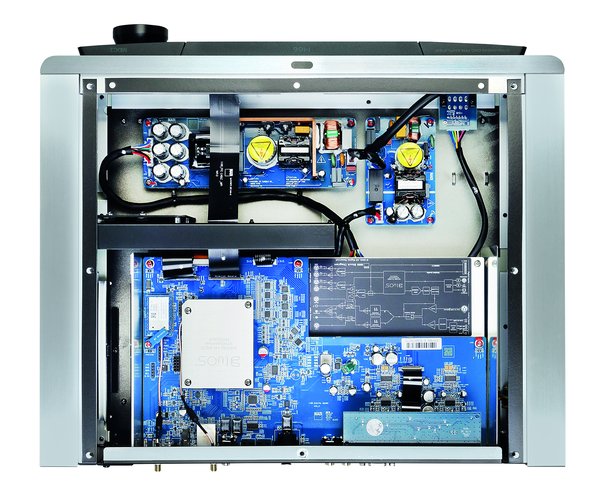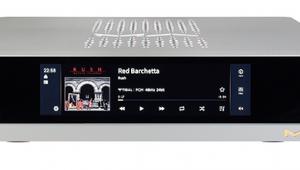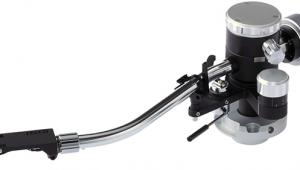NAD Masters M66

 Styled and with features to match the Masters M23 power amp, NAD's M66 streaming DAC/preamp takes on all-comers as both a digital and vinyl hub with Dirac onboard
Styled and with features to match the Masters M23 power amp, NAD's M66 streaming DAC/preamp takes on all-comers as both a digital and vinyl hub with Dirac onboard
First announced in the spring of 2023, unexpected delays to the arrival of NAD's M66 have only heightened anticipation of this flagship 'streaming DAC/preamplifier' - especially among owners of the company's Eigentakt-based M23 power amplifier who have been waiting for its companion product. And, yes, while the £4499 M66 could add its wide-ranging feature set (including app control and room correction) to any power amp, the M23 makes for an aesthetically pleasing fit.
Boasting the signature 'Masters' design of NAD's M series, the M66 hosts a black fascia 'floating' above a brushed alloy panel, and a 430mm-wide chassis with artily milled-out slots up top. It's an attractive look that separates NAD's top-tier range from its more affordable 'Classic' C series, without being ostentatious.
Getting In Touch
Following on from the M33 and other Masters products, the M66 is dominated by a 175mm touchscreen, flanked by a larger multifunction knob used to adjust volume and navigate through its various menus. Inputs are selected by tapping and swiping on the screen, as are various settings, and cover art is displayed during playback. It all works fluidly - even though I wonder how many people will make use of the touchscreen when the M66's partnering BluOS app, and its bundled (trapezoidal!) remote, offer the same controls.
So… are the M66 and M23 just a two-box alternative to the all-in-one, EISA Award-winning M33 integrated? No, because describing the M66 as the DAC and streaming stage of the M33, isolated in its own housing, would be easy but incorrect. The concept stays close to previous streamer/DAC-enabled models like NAD's C 658 or the M33, but new features make this preamp more capable still.
In particular, the manufacturer is especially vocal about the M66's ability to be used with up to four subwoofers (there are both single-ended and balanced connections), all managed via Dirac Live Bass Control, setting the M66 substantially apart from regular stereo products.
Recent NAD preamps and integrateds have typically sampled (digitised) their analogue inputs - which annoys purists - even if this step allows for applying room correction and DSP adjustments to say, vinyl playback. The M66 will do this if you want to employ Dirac correction or stream via BluOS, passing an analogue signal into its ES9822PRO ADC, but there's also an analogue direct mode that bypasses all digital processing. Furthermore, as both the analogue and digital stages are isolated from each other and possess separate power supplies, it seems NAD really wants to mollify its analogue critics.

Audio Hub
On the subject of analogue connections, the M66 is unusual in offering phono inputs for both MM and MC cartridge feeds. There aren't extensive loading options, but it still means NAD's preamp is more accommodating than most rivals. This is also true regards system building, where a wide array of inputs allows the M66 to become a versatile audio hub. Balanced XLR, AES/XLR and HDMI eARC are available, plus RS-232, trigger and IR control sockets.
Like much of NAD's hardware, the M66 claims a 'Modular Design Construction' and has two expansion slots for its (now second-generation) MDC plug-ins, which allow you to expand functionality. There's a bit of a 'jam tomorrow' aspect to this, as currently there's no relevant MDC2 card - a board with HDMI inputs, for instance - on the horizon. On the other hand, a streaming BluOS module is already built in.
This is a mature platform with good support for streaming services, Internet radio and music playback from the M66's USB port or over a network. Some premium streaming names are missing - Apple Music for one - but there are some nice niche options, such as the Neil Young Archive and the (free) FLAC streams offered by Radio Paradise. The BluOS module also supports Apple AirPlay 2 and Spotify Connect, plus Roon Ready status and Tidal Connect for audiophiles. Two-way Bluetooth with aptX HD codec support is, again, a feature you won't find on many competing products.
Recently, the BluOS app received a major update. As usual, not everyone likes the new design, but its quick selection of streaming options, presets and physical inputs on the M66 is very user-friendly. It's also easy to access the multiroom capabilities of BluOS for sharing music and sources connected to the M66 via other compatible products, including BluOS devices from Bluesound, Cyrus, DALI, Monitor Audio and Roksan (or vice versa).
When using any digital source on the M66, you can engage a new Dynamic Digital Headroom function. This is meant to prevent inter-sample peak clipping when converting the signal via the ES9038PRO DAC, which can in this case handle PCM up to 192kHz/24-bit. Note that DSD material can't be processed, even though the ESS device is up for it. Maybe a future MDC2 card will bring a solution for that, similar to the 'old' MDC DSD module?





















































